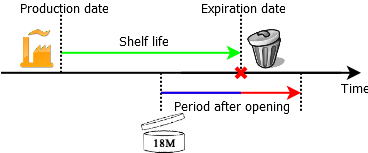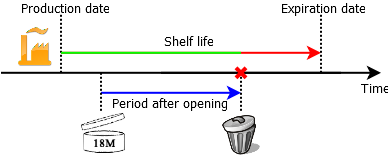Cosmetics shelf life F.A.Q.
1. Do cosmetics expire?
Yes, as any other products.
2. What are production date, expiration date and PAO?
Production date (or manufacture date) is the date when your product was manufactured. More precisely, it is the date when the batch of cosmetics (also called lot) was produced. This date can be printed on the package, but also can be omitted.
Expiration date is the date after which your cosmetic product will be expired and should not be used anymore. Usually this date must be specified only for the cosmetics which shelf life period is 30 months or less. If this date is present, it should be printed directly on product package in the form month/year or day/month/year, for example: Exp. 09/10 means that you can use the makeup only till September, 2010; Exp. 15/06/2010 means that makeup can be used only before 15 of June, 2010.
Such way, if shelf life of the cosmetic product is more than 30 months (e.g. 3 years), the expiry date probably will not be printed. But this doesn’t mean that you can use the product during whole 3 years or more.
 To clarify how long you can use your product once you opened it, Period after opening (PAO) sign is used. Try finding “open jar” sign with a number followed by the letter M, where number indicates how many months the product can be safely used for after opening. For instance, 6M means that product can be used during six months after opening; 12M means that product can be used during twelve months after you opened it etc.
To clarify how long you can use your product once you opened it, Period after opening (PAO) sign is used. Try finding “open jar” sign with a number followed by the letter M, where number indicates how many months the product can be safely used for after opening. For instance, 6M means that product can be used during six months after opening; 12M means that product can be used during twelve months after you opened it etc.
3. How can I determine exact expiration date for my cosmetics?
Your makeup will expire as soon as expiration date is reached OR end of PAO is reached.
You should maintain two terms:
- Expiration date. If it’s not specified, you can contact customer care department of the company who produced the cosmetics and ask for it, or as an option, calculate production date and approximate expiration date from the batch code via calculator on our website. We suggest still contacting customer care first of all in a case of any doubts.
- Period after opening (PAO). To easily find out when you opened a makeup, just apply any appropriate sticker to it, and write the current date when you opening it. As an option, you can write the date with marker directly on the packaging.
Basically there are two options:
- Expiration date will be reached first:

- PAO will be reached first:

Example: expiration date is printed on a package, e.g. Exp.:05/12, and PAO is also printed: 18M. Such way, in any case you should stop using this cosmetics after 05/12 or in other words, May 2012 (if expiration date is not specified, please feel free to use the cosmetic calculator to find it via the batch code).
But if PAO will be reached before the expiration date, this also can mean your product has been expired; for example, if you opened this cosmetic product on 16.02.2011, PAO will be reached after 6 months (6M), i.e. 16.02.2011 + 6 months = 16.08.2011; on 16.08.2011 your product will be expired and you should not wait for expiration date.
Other example: you opened this makeup on 25.02.2012; PAO will be reached on 25.08.2012, but expiration date (05/12, May of 2012) will be reached first, and you should throw out this cosmetics after May 2012.
4. Expiration date is not printed. How can I find it?
Contact customer care department of the company who produced the product and ask for it.
Or, as an option, find the batch code (also known as lot number) on the container or on the packaging, enter it to the cosmetic calculator and select the brand, then press Calculate button.
If the code can be deciphered, the production date and general shelf life period will be calculated. Please notice: provided shelf life information is common. Please visit official web site or contact customer care for exact shelf life period information for your product.
5. Why do they print batch code on cosmetics and perfume, what is it?
It’s a code which allows the manufacturer or supplier to identify the batch in which the product was produced. Usually it should be printed on both the primary container and outer packaging.
If the product was not made in a batch, then the code should enable the date and place of manufacture to be identified.
Often manufacturer can omit printing expiration date for the cosmetics which shelf life exceeds 30 months, but the batch code must be specified.
6. How long can I keep my cosmetics and be in safe?
Generally speaking, you can keep your cosmetics unopened up to 3 years. This is quite general term, and can depend from product and company produced it.
Please note: as soon as you opened it, you should also maintain the PAO.
7. What is average PAO for my mascara (lipstick, gloss etc)?
General period after opening is:
Perfumes, perfume, edp – up to 3 years;
Powders (including blush, eyeshadows powdery texture) – 1 to 3 years;
Foundation in a jar or a cream powder – 1 to 3 years;
Liquid tone means (in tubes or jars with dispenser) – 1 year;
Nail polish – 1 year;
Sun cosmetics – 1 year (but no more than one season);
Lipstick, lip gloss – 1 year;
Pencil (Eye, Lip) – about 1 year;
Skin care products (hydrating cosmetics, wrinkle, eye contour) in a sealed packet with the pump – about a year, in a jar – from 6 to 10 months;
Solid eyeliner and eyebrow pencil – from 6 to 8 months;
Bronzing – 6 months;
Mascara – 3-6 months;
Liquid eyeliner – from 3 to 4 months;
Natural/Organic products – up to 6 months.
Please note that natural and organic cosmetics, which do not include preservatives, can be stored up to 6 months after opening. Reason: absence of preservatives leads to a proliferation of bacteria.
8. How can I determine that cosmetic has been expired / not fresh?
The general rule is simple: as soon as you notice changes in your cosmetics – this means that the shelf life came to the end.
First of all, the smell: as soon as you feel any nasty notes, sharpness or rancidity, trash it.
Pay attention to appearance (sheen appears), texture (formed pellets, liquid consistency becomes heterogeneous), or gases have been formed in a tube – the shelf life is out!
It is very easy to determine “old age” mascara – as soon as it is dry, throw it away with no regrets, and in any case, do not try to “revive”.
Nail polish can be considered worthless, as soon as it began to thicken and harden.
Even if the recently purchased cosmetics were in the heat for quite a long time – do not use it anymore.
As a conclusion, if you have any suspicion about the appearance or odor of the product, it is better do not use it anymore. French National Institute for Consumer INC recommends do not use cosmetics after any visible changes in color, texture or odor.
9. What are possible consequences of expired cosmetics using?
In the best case, expired cosmetics just stop doing what it should do; it can change its appearance, smell and color, or become a sticky or oily.
In the worst case, expired cosmetics can result in skin irritation, dermatitis, allergic reactions and infection.